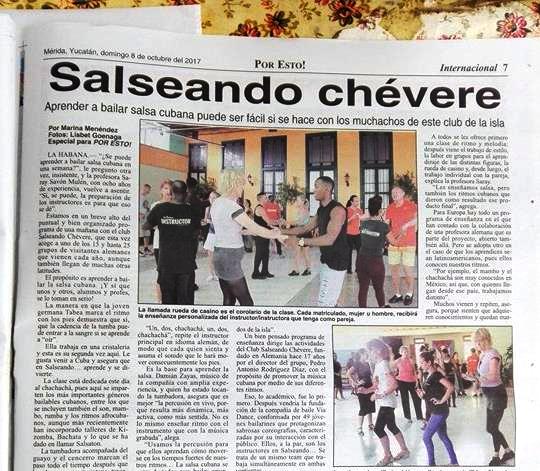
HAVANA .- "Can you learn to dance Cuban salsa in a week?" I ask again, insistently, and Professor Saray Savón Mulén, with eight years of experience, nods again. "Yes, you can, the training of the instructors is for that to happen."
We are in a brief stop of the punctual and well organized program of a morning with Club Salseando Chévere, which this time hosts one of the 15 and up to 25 groups of German visitors that come every year, although they also come from many other latitudes.
The purpose is to learn to dance Cuban salsa. And yes, both students and professors take it seriously!
The way the young German Tabea sets the rhythm with her feet proves that, the cadence of the Tumba can enter the blood if you learn to "hear."
She works at a glassware and this is her second time here. He likes to come to Cuba and says that in Salseando ... he learns and has fun.
The class is dedicated this day to the chachachá, because here the most important Cuban dance genres are taught, among them also son, mambo, rumba and Afro-Cuban rhythms, although more recently they have incorporated workshops of Kizomba, Bachata and what has been called Salsatón.
The tumbadora accompanied by the guayo and the cencerro mark the passage all the time after the students, about thirty, had the first approach to dance with one of the classic pieces of Cuban dance: "La Engañadora", by Enrique Jorrín.
"One, two, chachachá; one, two, chachachá, "repeats the main instructor in German, so that each one sits and assumes the sound that will make him move his feet consistently.
It is the basis for learning salsa. Damián Zayas, a musician with extensive experience, and who has been playing the tumbadora, says that it is better " live percussion, because it is more dynamic, more active, more felt. It is not the same to teach rhythm with the instrument that with the recorded music ", it alleges.
"We use percussion so that they learn how to move in the strong times of our rhythms ... Cuban salsa is nourished by all those dances from the island.
A well-thought-out teaching program directs the activities of the Club Salseando Chévere, founded in Germany 17 years ago by the group's director, Pedro Antonio Rodríguez Díaz, with the purpose of promoting Cuban music through its different rhythms.
That, the academic, came first. Then came the founding of the dance company viaDanza, made up of 49 young dancers who play the choreographies, characterized by their interaction with the public. They, at the same time, are the instructors in Salseando ... It is a same team that works simultaneously in both slopes.
The emergence of the dance group was a necessity. Here, in the academy, you work in groups and then individually with each student. That is why it is necessary the presence of sufficient instructors, both men and women, and they accompany the night out recommended to all enrolled so that can prove what has been learned in practice, in a real environment.
Gretel Reyes, responsible for Communication in the project, explains that they are very rigorous with the training of teachers. "We are organized in a way that we can constantly overcome. The most experienced teach the newest. "
Dancers / instructors should also strive with language. Although there is a main translator for the group classes, when they happen to the individualized ones each one "goes by its account".
The courses last one or two weeks, as the person chooses, who can go individually or in groups. Although last minute requests are taken care of once they are here, it is best that interested parties contact and make their requests by emailing coordinacion@salseandochevere.com, or going directly to the website www.salseandochevere.com. The offices are in the Bacardí Building, on Montserrate Street number 261, in Old Havana
THE ACADEMY
It is curious to see that the teaching of Cuban dances is governed by a program of classes, as for any other subject. In this case, even paying attention to the geographical origin of the student. Because, of course, a European learner of Cuban dances is not the same as one of Latin origin.
Everyone is offered a class of rhythm and melody first; then comes the work of style, work in groups for learning different figures, the rueda de casino and, of course, individual work with the couple, explains Professor Saray.
"We taught them salsa, but also the Cuban rhythms that resulted in that final product," he adds.
For Europe there is a whole program of teaching in which they have had the collaboration of a German teacher who is part of the project, also open there. But another is adopted in case the apprentices are Latin American, because they know our rhythms.
"For example, mambo and chachachá are very well known in Mexico, so, with those who come from that country, we work differently."
Many come and repeat, he says, because they feel that they acquire knowledge and are marked by our methodology, which is very own and has an internationally created profile.
Already the rueda de casino is formed and I am amazed when the leader sings the next turn: "Dile que no", and the male executors, among which there are also German students, make the corresponding corridor.
The contagious music of the Van Van floods the large terrace converted into living room, in the old house.
Andrés Trufín Abreu, founder of the group where he remains a veteran instructor, claims to feel happy. "I have the satisfaction that with my methodology, those who come for the first time dance, and leave happily."
"And what is his formula?" I ask.
"Correct them well and put a lot of dedication. My technique is patience. "
By: Marina Menéndez
Photos: Lisbet Goenaga
Taken from: Por Esto! México
Date: Sunday, October 8, 2017 Mexico
